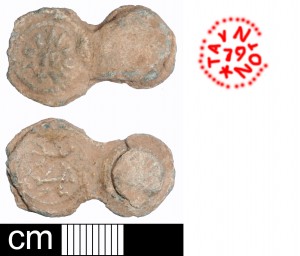
Cloth seals, although small and not much to look at, can give us fascinating insights into the Medieval and Post Medieval cloth trade, which was so important to economies of the period. This lead seal, SOM-B424B7, is of a form typical in England and some adjacent areas of the continent. It is formed of a row of four disks with tabs between. The row was bent in half over the edge of the cloth and a projecting point on one of the small outer disks went through the cloth then through a hole on the other outer disk before being stamped flat to rivet the ends together and to the cloth. The small disks appear plain apart from the raised circle from flattening the rivet. One larger disk is stamped with the legend *TAVNTON encircling 79 within a pellet border, the other has several faint raised lines, probably a ‘privy’ or ‘merchants’ mark.
Seals were attached to cloth at several stages of production. Personal seals might be added by the weaver and dyer, guild seals might also be added to show the quality of the work had been checked and it was of a required length and seals were added to show various taxes has been paid. This is almost certainly for serge cloth and Taunton seals with similar designs are known from the British Museum collections (Egan 1994: 51 and fig 23, no.97 and 98) and from Gloucester, Norfolk, Jamestown (Virginia) and Stockholm. It is suggested they are 17th century seals and the full date would read 1679, other dated examples include 1676, 1677 and 1674 (Egan ibid).
As cloth seals were discarded where the cloth was used, it is uncommon to find local seals (other seals from the same parish include a group from Ausburg, Germany). The VCH discussed the extensive cloth industry in Dunster and suggests: “The Dunster cloth industry spread to Carhampton before the end of the 16th century when clothiers, weavers and feltmakers were recorded. Weaver Edward Mills left two pairs of looms in 1635… and a weaver was recorded in 1713 but none thereafter” (Sireut 2010, Vol XII, in progress ). It is possible either that cloth from Taunton was consumed locally as well as exported or that Carhampton did not have its own mark but used the Taunton one and this seal was lost or removed before the cloth was exported.